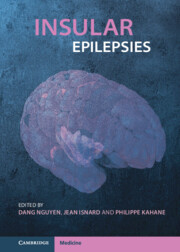Book contents
- Insular Epilepsies
- Insular Epilepsies
- Copyright page
- Contents
- Contributors
- Foreword
- Chapter 1 A Brief History of Insular Cortex Epilepsy
- Section 1 The Human Insula from an Epileptological Standpoint
- Section 2 The Spectrum of Epilepsies Involving the Insula
- Section 3 Noninvasive Investigation of Insular Epilepsy
- Section 4 Invasive Investigation of Insular Epilepsy
- Chapter 17 Invasive Investigation of Insular Epilepsy: Indications and Preplanning
- Chapter 18 Invasive Investigation of Insular Epilepsy: Surgical Techniques
- Chapter 19 Qualitative Interpretation of Intracranial EEG in Insular Epilepsy
- Chapter 20 Quantitative Intracranial EEG Signal Analysis in Insular Epilepsy
- Chapter 21 Electrical Stimulation of the Human Insular Cortex
- Section 5 Surgical Management of Insular Epilepsy
- Index
- References
Chapter 17 - Invasive Investigation of Insular Epilepsy: Indications and Preplanning
from Section 4 - Invasive Investigation of Insular Epilepsy
Published online by Cambridge University Press: 09 June 2022
- Insular Epilepsies
- Insular Epilepsies
- Copyright page
- Contents
- Contributors
- Foreword
- Chapter 1 A Brief History of Insular Cortex Epilepsy
- Section 1 The Human Insula from an Epileptological Standpoint
- Section 2 The Spectrum of Epilepsies Involving the Insula
- Section 3 Noninvasive Investigation of Insular Epilepsy
- Section 4 Invasive Investigation of Insular Epilepsy
- Chapter 17 Invasive Investigation of Insular Epilepsy: Indications and Preplanning
- Chapter 18 Invasive Investigation of Insular Epilepsy: Surgical Techniques
- Chapter 19 Qualitative Interpretation of Intracranial EEG in Insular Epilepsy
- Chapter 20 Quantitative Intracranial EEG Signal Analysis in Insular Epilepsy
- Chapter 21 Electrical Stimulation of the Human Insular Cortex
- Section 5 Surgical Management of Insular Epilepsy
- Index
- References
Summary
Invasive EEG investigation of the insular cortex has been performed with increasing frequency since the mid-nineties, in various forms of focal drug-resistant epilepsies. These include patients with a clear-cut intra-insular epileptogenic lesion, such as a focal cortical dysplasia, as well as patients whose non-invasive pre-surgical evaluation suggests perisylvian epilepsy, temporal plus epilepsy, sleep hypermotor epilepsy, MRI-negative frontal, and parietal lobe epilepsies. SEEG is currently the preferred method to investigate the insula, using orthogonal, oblique, or a combination of both trajectories, with no evidence of higher risk of intracranial bleeding than in other brain regions. Intra-insular ictal EEG patterns are often characterized by a prolonged focal discharge restricted to one of the five insular gyri, militating for a dense enough sampling of the insular cortex in suspected insular epilepsies. SEEG also offers the potential to perform thermolesion of insular epileptogenic zones which, together with MRI-guided laser ablation, represent a possibly safer alternative treatment to open-skull surgical resection of the insula.
- Type
- Chapter
- Information
- Insular Epilepsies , pp. 203 - 210Publisher: Cambridge University PressPrint publication year: 2022



